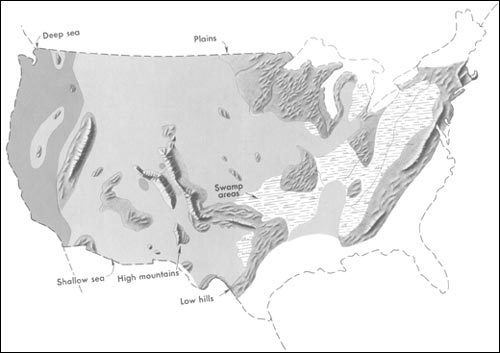 | ||
Pennsylvanian geology
The Pennsylvanian (also known as Upper Carboniferous or Late Carboniferous) is, in the ICS geologic timescale, the younger of two subperiods (or upper of two subsystems) of the Carboniferous Period. It lasted from roughly 323.2 million years ago to 298.9 million years ago Ma (million years ago). As with most other geochronologic units, the rock beds that define the Pennsylvanian are well identified, but the exact date of the start and end are uncertain by a few hundred thousand years. The Pennsylvanian is named after the U.S. state of Pennsylvania, where the coal-productive beds of this age are widespread.
Contents

The division between Pennsylvanian and Mississippian comes from North American stratigraphy. In North America, where the early Carboniferous beds are primarily marine limestones, the Pennsylvanian was in the past treated as a full-fledged geologic period between the Mississippian and the Permian. In Europe, the Mississippian and Pennsylvanian are one more-or-less continuous sequence of lowland continental deposits and are grouped together as the Carboniferous Period. The current internationally used geologic timescale of the ICS gives the Mississippian and Pennsylvanian the rank of subperiods, subdivisions of the Carboniferous Period.

Fungi
All modern classes of fungi have been found in rocks of Pennsylvanian age.
Vertebrates

Amphibians were diverse and common; some were several meters long as adults. The collapse of the rainforest ecology in the mid Pennsylvanian (between the Moscovian and the Kasimovian) removed many amphibian species that did not survive as well in the cooler, drier conditions. Reptiles, however, prospered due to specific key adaptations. One of the greatest evolutionary innovations of the Carboniferous was the amniote egg, which allowed for the further exploitation of the land by certain tetrapods. These included the earliest sauropsid reptiles (Hylonomus), and the earliest known synapsid (Archaeothyris). Small lizard-like animals quickly gave rise to many descendants. Reptiles underwent a major evolutionary radiation, in response to the drier climate that followed the rainforest collapse.
Subdivisions

The Pennsylvanian has been variously subdivided. The international timescale of the ICS follows the Russian subdivision into four stages:

North American subdivision is into five stages, but not precisely the same, with additional (older) Appalachian series names following:
The Virgilian or Conemaugh corresponds to the Gzhelian plus the uppermost Kasimovian. The Missourian or Monongahela corresponds to the rest of the Kasimovian. The Desmoinesian or Allegheny corresponds to the upper half of the Moscovian. The Atokan or upper Pottsville corresponds to the lower half of the Moscovian. The Morrowan corresponds to the Bashkirian.
In the European subdivision, the Carboniferous is divided into two epochs: Dinantian (early) and Silesian (late). The Silesian starts earlier than the Pennsylvanian and is divided in three ages:
